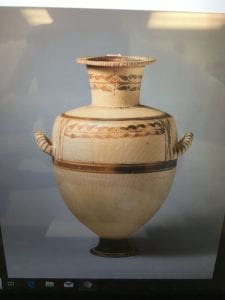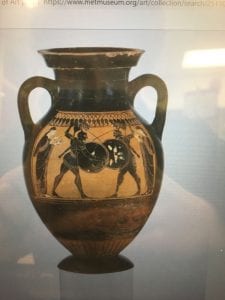When performing research on Greek vessels, I read about several Greek vessels. One of the vessels I researched was the Terracotta Hadra Hydria. It is a Hellenistic vase that was created around 3rd Century B.C. It was designed to be a water jar. When looking at the vase, it can be noted how the large body makes the vase a great tool for storing large quantities of water. The large handles and extended lips makes it easier to carry if someone needed to transport the vase or water plants. The vase is designed with stripes. The stripes are in the shape of vines and line stripes. This can represent the form of plants in that time and possibly the agriculture of the region. The artist used a dark iron form of embellishment, where the stripes and leaves are of iron color and texture, and the rest of the vase is a pink color due to the firing. The vase has a small base, and the vase has a large body used to store a lot of water. At the top, the lips are small and curved out. The pot exhibits the same geometric shape that is used to form many Greek artifacts.

Another vase I researched was the Glass Alabastra. The object was made in the 2nd to 1st century B.C. It was designed to store perfume. The long body suggest that the object could be used to store quantities of perfume that could be transported from place to place. The object was designed with stripes as it’s embellishments. In Greek artwork, stripes were the common embellishment. The artwork is black with white stripes. The object is a black figure with a narrow geometric body.

It is important for institutions like The Metropolitan Museum of Art to conserve and exhibit works from ancient cultures because the artwork can give insight on the lives of people living in ancient society. They can also give insight to the beliefs and the stories that are shared within ancient societies. For example, in the battle vase, one can see the armor and the battle tactics used in ancient Greece. The details on the shield and the soldiers’ armor describes the heavy equipment used in battle. Other types of vases will show the Greek gods, a household, or famous places that shows the development of Greek society. By protecting these pieces, researchers are able to get a sense of Greek society and how the people from the ancient world made art and used it to paint a picture of their daily lives.

https://www.metmuseum.org/art/metpublications/Ancient_Art_from_Cyprus_The_Cesnola_Collection_in_The_Metropolitan_Museum_of_Art
Great descriptions of the forms and incorporation of information beyond the vessel. How do you think the embellishment on the perfume bottle reveals how the vessel was made? How would you go about creating a similar embellishment with clay that reveals the process?